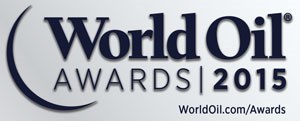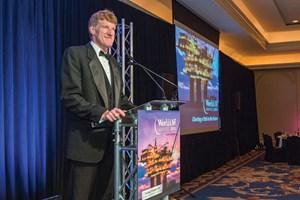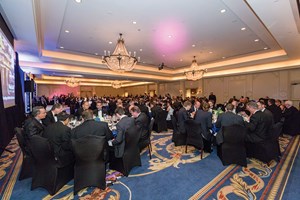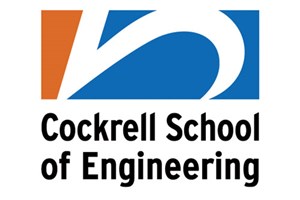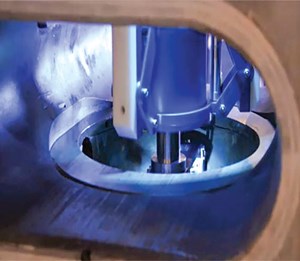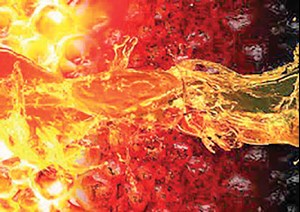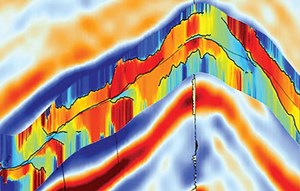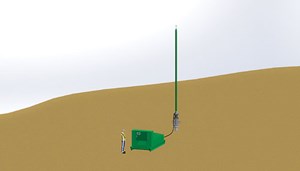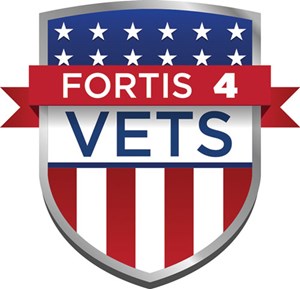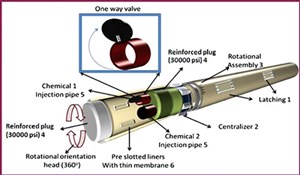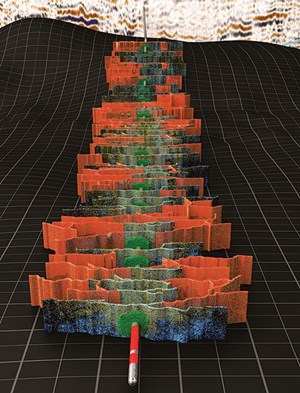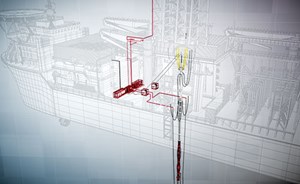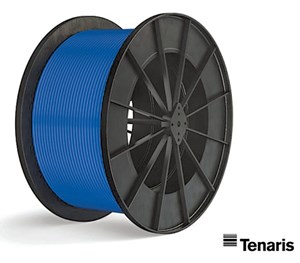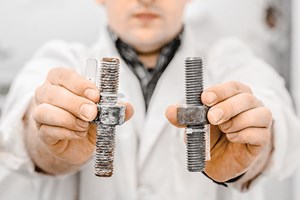A World of Innovative Achievements | Winners and Finalists
The 2015 World Oil Awards honored those “Charting a Path to the Future” in the oil and gas industry. The goal of the World Oil Awards is to recognize innovations and innovators, as well as the companies and their personnel, who create and develop technologies that drive the industry forward.
The 14th annual World Oil Awards honored winners and finalists in 18 categories, covering the continuum of the upstream oil and gas industry. This year’s winners took home trophies from The Houstonian Hotel on Oct. 15. The evening’s master of ceremonies and keynote speaker was Don McMillan, a technology engineer-turned-author and stand-up comedian, who kept the evening light-hearted and the audience laughing.
The 2015 awards were sponsored by Fairmount Santrol, Halliburton, Eddie V’s, Schlumberger, Zentech Inc. and CNPC. A/V Services were provided by Puresound, and event photography was provided by Gary Barchfeld.
The World Oil Awards endow leading universities with much-needed funds and encouragement to educate the industry’s future leaders. The recipient of this year’s university endowment was the Cockrell School of Engineering at The University of Texas at Austin.
On behalf of the World Oil Awards advisory board members, Gulf Publishing Company and World Oil, congratulations to this year’s winners and finalists. Your commitment to revolutionizing the industry with cutting-edge technology and innovative ideas will continue to inspire your peers and the next generation of leaders.
Judges and Award Methodology
The judging process for the World Oil Awards is conducted by an esteemed advisory board, made up of well-known leaders in the industry, with a diverse range of expertise. This group judges the shortlist of nominations. To ensure objectivity, all submissions are scored by a minimum of three judges, none of whom can be representatives of any of the submitting companies in the categories that they judge.
The 2015 World Oil judging team graded each submission on a scale of one to ten (with ten being the most suitable for the finalist list). In the first stage, the preliminary judges passed along the top five nominations for each category, unless total nominations exceeded 15, in which case six went on to the second stage. If there were less than five entries, then all nominations went on to the second stage of judging.
While the World Oil judging team made its finalist selections, an email went out to the advisory board (the second-stage judges,) asking them to select which award category(ies) they were able to judge. A board member cannot judge a category in which his or her employer is a finalist.
To protect the impartiality of the advisory board members who judge the final winners, their names are not published.
Keynote Speaker
Don McMillan, a technology engineer-turned-actor and stand-up comedian, delivered the keynote speech at the 2015 World Oil Awards. He also served as the event’s master of ceremonies. With an impressive background that includes a degree in electrical engineering from Stanford University, McMillan expressed his comical ideas about what makes an engineer, and how far we’ve come as a nation, and as an industry.
Following remarks from World Oil Publisher Andy McDowell, and a greeting from Editor Pramod Kulkarni, McMillan took the stage for a different style of keynote speech than what we’ve seen in previous years.
Keeping the evening light-hearted and entertaining, McMillan poked fun at those making predictions as to where the industry is headed. He compared the predictions to those made by CBS’s television series, “The 21st Century,” hosted by Walter Cronkite in the late 1960s. As it turns out, they were right about computers, mobile phones and electric cars. However, he quipped that they were wrong about the popularity of jet packs, flying cars and robot servants, which indicates that some of these oil predictions should probably be taken with a grain of salt.
In keeping with the event’s technology and innovation theme, McMillan also gave the audience a visually uproarious picture display, showing how far we’ve come since the first issue of World Oil was published in 1916. Using common household items and industry terms, he kept the audience laughing. In 2015, a Blackberry is illustrated as a mobile phone device, while it is shown as a simple, purple-hued berry on a bush in years gone by.
Later, he had a roomful of petroleum engineers in stitches with a diagram illustrating the differences between a geek, a nerd and a dork. He then observed the current state of the market by comparing the price of crude oil to the outrageous price of printer ink cartridges, going as far as to suggest various ways to save money, including a witty and staged photo of himself pumping his own blood into an
HP printer.
After winning the television competition series, “Star Search,” in 1993, and with stand-up comedy experience, including appearances on “The Tonight Show” on NBC and CNN’s “Larry King Live,” McMillan’s engineering background allowed him to cleverly tailor his jokes to the audience.
“Don was a wonderful MC. He offered a unique perspective on our business from outside the industry, while keeping the topics focused on engineering, technology and innovation,” McDowell said of the keynote speaker. “He was extremely funny, and I feel that the audience really enjoyed the presentation and evening overall. Their laughter throughout his speech was a clear sign that they were having fun.”
Beneficiary University
The Women in Engineering Program in the Cockrell School of Engineering at The University of Texas at Austin is a student service for all engineering women, creating a network of engineering peers and professionals by providing academic, career and leadership opportunities.
Best Completion Technology
This award recognizes the leading solution that provided a substantial impact on the industry’s completions. Criteria for the award include innovation, reliability, commercial application and industry impact.
Finalists:
- F-T90 Horizontal frac tree and monoline frac fluid delivery system, Cameron
- PowerJet Nova extra-deep penetrating shaped charge, Schlumberger
- Propel SSP proppant transport technology, Fairmount Santrol
Winner: MultiCycle frac sleeves, NCS Multistage
Reclosable MultiCycle frac sleeves permit stages to be stimulated out-of-sequence, to counter the effects of stress shadowing. The sleeves can be opened and closed, as needed, to provide unprecedented flexibility and control for completion, production and remediation operations. During the original completion, the casing sleeves are operated by the coiled tubing-deployed Multistage Unlimited frac-isolation tool. For well remediation and restimulation, intervention-style, coiled tubing tolls are used to operate the sleeves, and to straddle and isolate target zones. A virtually unlimited number of MultiCycle frac sleeves can be run as part of a casing or liner string. The sleeves retain the proven features, operability and reliability of standard NCS casing sleeves. They are full-drift at all times, handle like casing joints, and can be added to the casing string in any order. The sleeves enable pre-frac injection testing of any planned zone, instead of just at the toe, giving operators information needed to tailor the stimulation to different formation properties along the lateral. During stimulation, each sleeve can be closed immediately after fracturing to allow frac healing, and to prevent proppant backflow. They also can be used to prevent treatment from re-entering the well above the tool string, and causing potentially costly problems. To date, more than 6,000 MultiCycle frac sleeves have been installed in approximately 250 wellbores. They have successfully shut off proppant inflow after fracturing, and have been used to control water inflow in horizontal waterflood projects in the Shaunavon and Canadian Bakken, where they contribute to reducing decline rates by more than 10%.
Best Data Management & Application Solution
This award is given for an implemented, viable workflow solution, focused on data storage, delivery or management processes and technologies, that provided tangible results for an operator or service company.
Finalists:
- Baker Hughes information reservoir, Baker Hughes
- CIRCA REAL-TIME (RT) modeling software, Baker Hughes
- DecisionSpace borehole data management software, Halliburton
- Production loss tracking and reporting (PLT&R), Kuwait Oil Company
- SENSU rig operations surveillance and instrumentation system, Geoservices, a Schlumberger company
Winner: Non-destructive BOP inspection technology—4D digital fingerprinting, GE Oil & Gas
The GE Oil & Gas non-destructive BOP inspection technology system leverages 4D digital fingerprinting technology to inspect complex BOP systems without disassembly. By creating a 3D digital fingerprint of the current condition of equipment, the inspection technology compares change over time against a baseline, detecting wear, and enabling informed and proactive maintenance decisions. The GE system enables inspection, testing and recertification on a rig, eliminating the need to transport systems to shore or disassemble for testing. As a result, customers experience reduced downtime, cost savings associated with transportation of BOP systems, decreased risks associated with teardown, and enhanced maintenance planning around the operations schedule versus unplanned interventions. By applying the BOP inspection technology system, GE can inspect a BOP without complete teardown, and can quickly identify repair needs. The speed of the system also enables more frequent inspection, maximizing the performance of key systems. This reduces the recertification cycle by 40%, and creates a digital record to drive condition-based maintenance.
Best Deepwater Technology
This award recognizes significant technology in the area of drilling, completions and production in deepwater applications.
Finalists:
- InLine ElectroCoalescer (IEC), FMC Technologies
- Meta Liner Tieback, Meta Downhole
- VisiTrak Geospatial Navigation and Analysis Service, Baker Hughes Incorporated
Winner: Hammerhead Ultra-deepwater Integrated Completion and Production System, Baker Hughes Incorporated
The Hammerhead system is a fully-integrated wellhead-to-reservoir completion and production system, built for ultra-deepwater conditions and production demands. Fully assembled, the system includes an upper completion, a single-trip multizone lower completion, an isolation assembly and intelligent production capabilities. It can deliver as much as 5,000,000 lb of proppant at up to 50 bbl/min. into as many as five zones, for optimal reservoir connectivity and conductivity. Robust setdown and upstrain capabilities increase reliability and simplify operations. A 5¼-in. minimum production inside diameter—the industry’s largest for a high-pressure 8½-in. drift completion—allows it to handle flow rates up to 30,000 bopd over the life of the well. Additionally, industry-leading differential pressures up to 15,000 psi, combined with subsea boosting technology, help to reduce abandonment pressures for maximum reservoir drainage. Monitoring technology, including distributed temperature-sensing fiber optic cables and electronic pressure and temperature gauges provide a continuous stream of real-time data, and dual-choking, hydraulic intelligent well system valves enable selective zonal control to enhance production. The Hammerhead system encompasses a new portfolio of technology, designed specifically for conditions up to 25,000 psi and 300°F. Developed using a holistic engineering approach, it offers total integration to reduce operational risk, and to eliminate the burden of multi-vendor integration.
Best Drilling & Completion Fluids
This award recognizes an innovative drilling or completions fluid, or a fluid-related mechanism or process that was commercially introduced within the last year, and which helped to drill for, or produce, oil or gas.
Finalists:
- MVP Frac, Trican Well Service
- SaltShield Cement, Halliburton
- XPLOR Dry Emulsifiers, Georgia-Pacific Chemicals
Winner: RHELIANT PLUS Drilling Fluid System, M-I SWACO, a Schlumberger company
The RHELIANT PLUS drilling fluid system maintains thermal stability, consistent rheological properties, and protection from barite sag in deep water and extended-reach drilling operations, despite major temperature fluctuations between the formation and riser. Additionally, the system has excellent hole-cleaning capabilities, reduced operating costs and lower potential for loss of circulation. Improved tripping speeds save rig time, and the associated cost reduction goes straight to the bottom line of the operator. A non-aqueous fluid, RHELIANT PLUS, maintains nearly constant physical properties, independent of temperature and pressure. Its stable rheological properties and gel structure allow drilling and break circulation pressure with lower equivalent circulating densities, which contributes to the prevention of problems while drilling. Hydraulic variations from surge and swab effects are eliminated by simple formulation in the field, which results in greater stability than other fluids. The drilling fluid also exceeds its predecessor’s temperature rating by as much as 80°F (29.6%). Conversion to RHELIANT PLUS requires no changes in operation and can be effectively carried out from a wide range of non-aqueous fluids. Engineers formulated the drilling fluid with a 65-to-35 synthetic-to-water ratio, using a paraffinic base fluid. The thermally stable drilling fluid has worldwide applications, from the hot wells of India and Thailand, to the frigid Barents Sea.
Best Drilling Technology
This award goes to innovators, who executed an industry-leading effort during the year that had a significant impact on the industry, onshore or offshore, through drilling innovation.
Finalists:
- AirLock Casing Buoyancy System, NCS Multistage
- Auto Trak eXact High-Build Rotary Steerable Drilling System, Baker Hughes Incorporated
- Drillmec AHEAD rigs, Drillmec
- JetStream RFID Drilling Circulation Sub, Weatherford International
- R-550D Jack-up drilling rig, Zentech
- StingBlade conical diamond element bit, Smith Bits, a Schlumberger company
Winner: GeoSphere reservoir mapping-while-drilling service, Schlumberger
The real-time GeoSphere reservoir mapping-while-drilling service continuously images a spherical volume of formation, with a 360° radius of 100 ft. Based on its ability to produce deep, directional electromagnetic measurements, the service reveals subsurface bedding and fluid contact details of unprecedented clarity and resolution. The service successfully bridges the gap between wellbore measurements and surface seismic, making it unique to the industry. Featuring the highest available depth of investigation, the service enables operators to detect reservoir “sweet spots” within a huge volume surrounding the borehole, optimizing landing, maximizing reservoir exposure and refining field development plans. Because measurements are acquired while drilling, formation alteration from drilling fluid invasion is minimized. Images are rendered in real time to enable precise steering decisions, delivering a smoother trajectory away from geological and drilling hazards. The image is so clear that the costly need for pilot holes is eliminated. The service allows operators to see anomalies develop, or shrink, resulting in more effective decision-making. Using GeoSphere imaging, significant reservoir volumes are evaluated on a single pass, and better production and completion decisions result. Additionally, drill risk is minimized, and images help refine geological maps and 3D reservoir models post-drilling. Not only are subsurface boundaries precisely identified and mapped, but fluid contacts and geohazards can be imaged and evaluated as well. GeoSphere data are more valuable, because the entire formation volume within 100 ft surrounding the borehole is described in detail, on a single trip, with a single pass.
Best EOR Technology
This award is given to a company whose innovative EOR technology has enhanced crude recovery substantially.
Finalists:
- AERO System, Glori Energy
- Microwave in-situ steam generator for heavy oil recovery, Saudi Aramco
- NextWave production rejuvenation solution, Baker Hughes Incorporated
- SmartPlex Downhole Control System, Halliburton
Winner: WASP (Wireline Applied Stimulation Pulsing), Blue Spark Energy
The WASP technology provides an innovative, efficient, low-cost, low-risk oil and gas well stimulation method that dramatically increases productivity with much less impact on the environment. It utilizes the science of high-pulsed power to stimulate the reservoir rock. It converts, compresses and discharges electrical energy as usable, repeatable, high-power hydraulic pulses—electricity converted to a shockwave in a fluid. The WASP stimulation also creates micro-fractures in the near-wellbore rock, creating new flow pathways, which increases the area through which fluids can flow. This improves connectivity between the wellbore and reservoir. WASP technology is proven to enhance oil and gas flow in new or poorly producing wells, and recover reserves from non-producing wells. The tool can stimulate a vertical well, with up to 72 ft of interval in an 8-hr work day. When deployed on electric coiled tubing, with a wireline tractor or pump down, it can stimulate horizontal wells, too. It provides an efficient, cost-effective and safe alternative to the traditional methods used to remediate near-wellbore damage, such as matrix acidization, hydraulic fracturing, propellants and perforating. Additionally, it has a much smaller environmental footprint. There is no need for explosives or propellants, it does not damage the formation rock or completion equipment, and it does not require zonal isolation for operation of the service.
Best Exploration Technology
This award is given for the leading acquisition technology (including seismic, geochemistry and remote sensing) or algorithm/processing technology introduced during the previous year.
Finalists:
- DecisionSpace Geosciences Software for Automated Fault Detection, Halliburton
- IsoMetrix marine isometric seismic technology, WesternGeco
- Petrel 2014 user experience, Schlumberger
- Quanta Geo photorealistic reservoir geology service, Schlumberger
Winner: 3D mapping of reservoir saturation from crosswell electromagnetic in horizontal wells, Saudi Aramco and Schlumberger
The crosswell EM method consists of transmitting and receiving an EM signal in two adjacent wells, performing a tomographic mapping. The transmitter logging tool is deployed in one wellbore to broadcast a continuous EM signal (with a frequency selected by modeling and simulation of borehole environment, well separation and formation resistivity), which is 100,000 times stronger than the source in a conventional single-well induction logging system. The signal traverses the formation between the wells to the receiver station in the other wellbore. Once the transmitter EM profile is recorded, the receiver tool is repositioned, and the process is repeated to cover all the reservoir section. Data are processed through 3D inversion to obtain a tomographic 3D cube of resistivity of the interwell reservoir volumes. The collected resistivity data are interpreted together with wellbore logs, to provide interwell comprehensive reservoir water saturation, with objective to evaluate sweep efficiency and ultimately maximize oil production and recovery. Crosswell EM increases the scale of resistivity logging to deliver a more detailed and larger picture, providing the reservoir management information necessary to optimize sweep efficiency and identify bypassed areas to increase hydrocarbon recovery. The application of this interwell EM technology to widely spaced, deviated and horizontal wells is a potential game-changer for understanding reservoir saturation, particularly in fractured reservoirs.
Health, Safety, Environment/Sustainable Development—Offshore
This award is presented to a company that has made significant strides in protecting and enhancing the offshore environment where it operates. Whether through technical innovations, implementation of new standards or processes, or introduction of social and economic development efforts, the winner will have a program that made a marked improvement in an HSE/sustainable development endeavor.
Finalists:
- Enhanced Laser Diode Spectroscopy, Senscient and Suncor
- MaxForce Flow Ultra-Kleen Perforating Technology, Halliburton
- New Acid Systems: Alternatives to HCL and Organic Acids, Baker Hughes Incorporated
- SCREEN PULSE fluid and cuttings separator, M-I SWACO, a Schlumberger company
Winner: Safety Lock Module, National Oilwell Varco
The Safety Lock Module was designed as a standard component of the ShockForce drilling jar. The feature keeps the jar locked safely while at the surface, and automatically unlocks the jar downhole using hydrostatic pressure. The module eliminates crew interaction with double-acting hydraulic jars prior to running in hole, preventing the need for a traditional external safety collar. The technology allows the safety lock mechanism to keep the tool open until it is run in hole. When exposed to certain hydrostatic pressure (typically 300 ft to 400 ft, vertical depth), the tool automatically unlocks and turns into a freely stroking hydraulic jar. Conversely, when tripping out of hole, the safety lock mechanism automatically causes the jar to relock just before it reaches the surface. It puts an end to falling objects from the racked-back hydraulic jars, and enables top-of-the-line drilling jar technology to be run in hole safely. The module is designed to withstand downhole pressures up to 25,000 psi. It increases safety and efficiency, and eliminates the need for external mechanical safety collar. Automation reduces equipment damage and eliminates the possibility of lost or damaged safety collars. The Safety Lock Module allows the industry to dramatically reduce safety risks by limiting interaction with the jar.
Health, Safety, Environment/Sustainable Development—Onshore
This award is presented to a company that has made significant strides in protecting and enhancing the onshore environment and communities where it operates. Whether through technical innovations, implementation of new standards and processes, or introduction of social and economic development efforts, the winner will have a program that made a marked improvement in an HSE/sustainable development endeavor.
Finalists:
- CleanSpacer III spacer fluid, Halliburton
- Electro Water Separation (EWS), OriginClear
- Environmentally Friendly Drilling Systems Program, Houston Advanced Research Center
- Modular Frac-flowback & produced water treatment train technology, NSERC/ARIS-ET
Winner: EnviroLift, Weatherford International
The EnviroLift pumping unit addresses factors, such as intolerance for leaks, restricted land usage, visual pollution and an emphasis on safety issues. It has zero potential for all-too-common stuffing box leaks, because it features no stuffing box, polished rod clamp or polished rod. The system uses environmentally friendly hydraulic fluid to power the pump. Its slender design lends itself to camouflaging, to better blend into the surrounding landscape. The unit is attached directly to the wellhead, without the need for guy-wires, so units can be placed closer than hydraulic pumping units that rely on guy-wires for stability. The lack of guy-wires adds to the safety of the system, as they can easily go unnoticed and lead to personnel injury, vehicle damage and damage to hydraulic units from vehicles or well servicing equipment. The pumping unit is designed to withstand 100-mph winds, and includes dual 5,000-lb BOPs. All moving parts are safely encapsulated within the cylinder, and the power unit is contained in a lockable enclosure. The system requires no site preparation, and uses less manpower and time than conventional long-stroke units. Additionally, long-term maintenance costs are minimal, due to the few moving parts. With specific features for enhanced safety, environmental protection, space efficiency and cost-effectiveness, the EnviroLift system has evolved from earlier hydraulic rod lift designs, with features that make it suitable for next-generation operations for multi-well pads and populated areas.
Best Outreach Program
This award spotlights a program that has done the best job of teaching the general community, and younger generation, about the value of the oil and gas industry, which is often one of the greatest challenges confronting the sector.
Finalists:
- LAGCOE Education Fund, Louisiana Gulf Coast Exposition (LAGCOE)
- PETROSAINS, The Discovery Centre, PETRONAS (Petroliam Nasional Berhad)
- Women’s Resource Group—STEM, Baker Hughes Incorporated
Winner: Fortis 4 Vets Program, Fortis Energy Services
Fortis Energy Services instituted a Veteran Employment Initiative. The initiative offers a transition into a dynamic, exciting career in the energy industry, ensuring compliance with USERRA and all military leave acts. Veterans enjoy 100% employee paid benefits, competitive pay, paid vacation, 401k plans, on-the-job training and more. With a deep understanding of the sacrifices made by veterans and the challenges they face in pursuing careers in both the military and civilian life, Fortis recognizes the benefits that come from hiring people with military experience, appreciating the values, skills and personal attributes that veterans and those currently serving in the military possess. They understand how these skills and attributes can add significant value to the company. In further developing this program, Fortis reached out to all communities in which they operate, to get involved in Veteran Job Fairs, and to team up with other organizations that are promoting the hiring of veterans, reservists and guardsmen. Approximately 10% of Fortis’ employees are former or current military personnel.
Best Production Chemicals
This award is given to a company whose innovative stimulation or treatment chemicals have enhanced the production of oil and gas.
Finalists:
- ParaSorb solid paraffin inhibitors, Baker Hughes Incorporated
- SAPINT, PDVSA INTEVEP
- TOLCIDE PS A Series, Solvay Novecare
Winner: Chemically-induced pulse fracturing for unconventional reservoirs, Saudi Aramco
Chemically-induced pressure pulse fracturing is a novel fracturing technology, based on a pressure pulse generated by chemical reaction. The invention is a cost-effective fracturing technology, which increases stimulated reservoir volume around a wellbore to unlatch unconventional gas. The concept is based on injecting reactive chemicals in a wellbore, which upon triggering, generates in-situ pressure pulses, creating multiple fractures. The reaction generates a pressure pulse of nitrogen gas of up to 40,000 psi, and can be tailored to the required fracturing pressure by controlling reactant concentrations and volumes. With chemically-induced pressure pulse fracturing, pressurizing time can be controlled, so fracturing pattern can be optimized. It also allows for inert gas expansion, creates multiple fractures and can be oriented into one dominant fracture, using niches and perforations. The technology provides a cost-effective stimulation technique that potentially reduces fracturing cost by 80%, and allows commercial development of unconventional gas. It has been developed to increase stimulated reservoir volume around the wellbore and fracture area, and therefore, improve unconventional gas production. Moreover, the new method will remove trapped liquids around the fracture, improve conductivity, and ultimately enhance the commerciality of unconventional tight gas development.
Best Production Technology
This award recognizes a newly introduced production program, solution or fluid utilized during the year that allowed an operator to effectively manage and maximize production.
Finalists:
- CAMLIFT Linear Lifting System, Schlumberger
- FracHeight Service, Halliburton
- REDA Continuum unconventional extended-life ESP, Schlumberger
- RockPerm Service, Halliburton
- Sand Tolerant Pump, Weatherford International
Winner: AccessFrac, Halliburton
The AccessFrac Stimulation Service is a multi-cycle fracturing technique that utilizes an engineered treatment design with high-fidelity diversion spacers to segregate multiple proppant cycles, to help ensure maximum stimulated wellbore coverage. The service provides a solution to the complex interaction of stage configuration, cluster spacing, material volumes and number of proppant cycles, to help deliver greater stimulation effectiveness and financial success through improved production in challenging modern completions. By controlling the flow area for each proppant cycle, wellbore sections can be stimulated more efficiently. This equates to better distribution of the treatment proppant across the producing interval, resulting in uniform fracture half-lengths, which can mitigate well-to-well interference and prevent bypassed reserves, due to ineffective cluster efficiency. The multi-cycle designs also allow for a larger section of the wellbore to be stimulated in each stage, which requires fewer mechanical isolation devices. The process increases the bottomhole stimulation pressure, which increases the potential to place sand in secondary fractures. The diversion materials used to isolate each fracturing cycle are environmentally benign, and they self-degrade in any aqueous fluid, leaving non-toxic liquid byproducts behind that do not interfere with recycling or disposal of recovered water. The service is effective in both multi-zone plug-and-perf completions and openhole sliding sleeve completions. It limits the preferential growth of each fracture volumetrically, to achieve better fracture coverage, uniform stimulation treatment and more evenly distributed production across the wellbore. Infill wells or refracs can be avoided, potentially saving millions of dollars and delivering the lowest cost per BOE.
Best Visualization and Collaboration
This award recognizes the data visualization, storage, software or manipulation solution that shows the greatest promise in enabling operators to achieve and create a real-time collaborative environment with potential for a step-change in operating efficiency.
Finalists:
- FieldPlan Express Software, Halliburton
- Invizion Evaluation well integrity service, Schlumberger
- Marlin Solution, ION
- Neftex Regional Frameworks in DecisionSpace Software, Halliburton
- PRODcast Vx production testing monitoring software, Schlumberger
- Smart Driller Indicator (SDI), China National Petroleum Company (CNPC)
Winner: ePLUS Retina monitoring system, Packers Plus Energy Services
The ePLUS Retina monitoring system is designed to verify downhole events, detecting multi-stage completion system operations and their effects on the reservoir. The self-contained monitoring unit operates independently of a completion system and does not interfere with stimulation operations. Specially designed sensors relay information from the well to the Retina monitoring system, which takes up a very small footprint on location. Additionally, built-in redundancy features for all measurements ensure timely and accurate data are being captured. Data from the Retina monitoring system can be correlated in real time with surface pressure, as well as slurry flowrate and blended proppant density, to accurately monitor downhole operations. Since its launch in 2014, the Retina monitoring system has been deployed in the U.S., Canada and Saudi Arabia. It has been used to capture data from more than 500 fracture stages. The system provides a cost-effective way for operators to visualize their multi-stage completions, enabling sudden operational adjustments to ensure a successful stimulation, as well as provide valuable information for future wells.
Best Well Integrity Technology
This award recognizes a company with technical, operational or organizational solutions, which reduce the risk of uncontrolled release of formation fluids and provide E&P operators with an increased level of well integrity assurance.
Finalists:
- Gas preventing cements, Saudi Aramco
- GaugePro Echo Digital Reamer, Baker Hughes Incorporated
- CEMENTICS zonal isolation software, Schlumberger
- Multibowl Nested Diverter Snap ring (MN-DS) wellhead system, Cameron
Winner: Deepwater MPD System, including MicroFlux Control System, Weatherford International
The deepwater managed pressure drilling (MPD) system enables continuous closed-loop monitoring of the well, and automates early kick and loss detection and control. Automation capabilities help prevent and keep influx volume at a minimum, before it reaches the well control threshold margin in the kick tolerance matrix. Moreover, it facilitates engineering, planning and execution of the well. Automated influx detection is beneficial, because it keeps influx size smaller than possible with conventional detection methods. The scalability of MPD provides the ability to incrementally apply the technology, which eases its adoption process, and leads to more rapid acceptance and use of the full set of deepwater MPD system capabilities. The use of this technology in emerging deepwater markets is set for rapid expansion, either as a proactive installation to maximize operational safety and efficiencies, or a reactive installation in response to an event that MPD could have prevented.
Best Well Intervention
This award is for advances in well maintenance, which can represent the highest expenditure over the life of a well. This award recognizes new intervention technologies that help make significant improvements in terms of time saved, costs reduced or production improved.
Finalists:
- ACTive OptiFIRE CT real-time selective perforating and activation system, Schlumberger
- ACTive Straddle CT real-time multiset inflatable packer, Schlumberger
- CoilComm Services, Halliburton
- Hydraulic Pulling Tool System, Baker Hughes Incorporated
- impaCT Integrated wellbore preparation service, M-I SWACO, a Schlumberger company
- Rig-Free light-duty pulling and jacking unit, Weatherford International
Winner: BlueCoil Technology, Tenaris Coiled Tubes
Designed to expand the capabilities of coiled tubing and to raise operational reliability and performance of well intervention, BlueCoil Technology is stronger, more fatigue-resistant and less susceptible to hydrogen sulfide attack. The technology represents a significant departure from conventional coiled tubing manufacturing. The microstructure and properties of BlueCoil string are obtained during the last step of manufacturing, through a continuous heat treatment process that is uniformly applied to the entire coiled tubing string. The steel is fully transformed, essentially erasing the local microstructural variations produced during strip and tube forming, and welding. BlueCoil products have demonstrated up to a 2.5x increase in base tube fatigue life, and as much as a 4x increase in bias weld fatigue life. The measured 50% reduction in tube ballooning will also contribute to longer string life and lower cost, in situations where diameter growth has required premature string retirement. BlueCoil coiled tubing has been used for cleanouts, acidizing, fishing, plus milling, abrasive perforating and annular fracturing, all the while delivering better reliability, operational efficiencies and cost-savings.
Innovative Thinker
This award honors an individual who has demonstrated thought leadership in the upstream oil and gas sector. The winner will be an inspiration to all and a champion of the industry, not only in terms of the breadth of achievements, but also through the demonstration of vision and innovative thinking.
Finalists:
- John Chisholm, Flotek
- Andrew Churchill, Churchill Drilling Tools
- Ramesh K. Maini, Zentech
- Vita Martez, Southern Alberta Institute of Technology
Winner: Philip M. Snider, PMSnider Consulting
Snider began his career as a drilling engineer and rig supervisor with Marathon Oil Company in Casper, Wyo., in 1979, and later as a reservoir engineer. He subsequently relocated to Alaska as a production engineer, followed by two years in Lafayette, La., as a completions supervisor for projects in the western Gulf of Mexico. He transferred to Houston in 1989, and has worked in various technology service groups associated with drilling and completions, advancing to the level of senior technical consultant. Today, he is an independent consultant in well completions technology. In Snider’s 34-year career at Marathon, he provided technical consultation regarding completions to engineers, geoscientists and management on a worldwide basis. Additionally, he has taken part in a significant amount of industry training, including SPE short courses. He holds approximately 30 patents, and has published more than 30 technical papers and journal articles related to completion technology. Snider is a past SPE distinguished lecturer, and a past chair of API’s Perforating Subcommittee, as well as a member of the API Explosives Safety Committee. In 2012, he was awarded the SPE Gulf Coast Regional Completions Optimization and Technology Award. He retired from Marathon Oil in 2013.
Lifetime Achievement
This award honors an individual, who has made significant strides, and impacted the oil and gas industry, throughout his or her career. The recipient may be retired from the industry, but will be an individual whose legacy still has an impact. [Nominee must be living].
Finalists:
- Saad AlDriweesh, Saudi Aramco
- Dr. Alan R. Huffman, SIGMA3
- Rustom K. Mody, Baker Hughes Incorporated
Winner: Tore Halvorsen, FMC Technologies
With more than 30 years of experience in subsea field development, including design and development, technical and project management, Halvorsen has been a pioneer in leading the development and implementation of subsea technology for the global oil and gas industry. He became managing director of FMC Kongsberg in 1994, and now serves as senior V.P. of FMC Technologies. He has advanced the company’s solutions to the challenges of the industry, and has been influential in growing the company’s subsea business, which accounts for more than 70% of its total revenue. He has played a key role in developing standard subsea solutions, including the first diverless subsea field, as well as the HOST (Hinge Over Subsea Template), paving the way for Statoil’s massive subsea field developments on the Norwegian Continental Shelf. Halvorsen has been instrumental to Norway’s subsea industry, and is even recognized within the international oil and gas community as “Mr. Subsea.” Additionally, he has received a number of awards for his contributions, including “Oilman of the Year 2009” by SPE Norway.
New Horizons
The winner of this award is a company with a game-changing product, technology or idea that redefines the industry’s thinking. The winner of this award symbolizes how the industry will operate in the future and will serve as a guidepost to the next generation of leadership entering today’s upstream energy sector.
Finalists:
- INTERSECT simulator in the Cloud, Schlumberger
- KRYPTOSPHERE HD ultra-conductive, high-density ceramic proppant, CARBO
- MicroScout Service, Halliburton
- OneSubsea HyFleX Tree System, OneSubsea, a Cameron and Schlumberger company
- Self-powered pipelines/wellbore hydrate prevention system, Saudi Aramco
Winner: Modumetal, Modumetal, Inc
Using advanced nanolayering technology, Modumetal is able to produce an entirely new class of metals using the same raw materials as traditional steels and metal alloys, but with dramatically improved properties and performance. The materials are stronger and lighter, more durable and corrosion-resistant than conventional metals. By controlling the interface between metal layers at a nanometer scale, Modumetal enables new metal configurations, which can be combined in myriad arrangements to architect materials with properties never thought possible. The low-CAPEX production process uses electricity rather than heat, facilitating production at room temperature. Energy saved during the manufacturing process translates to a cost-savings passed on to customers. Modumetal’s nanolaminated coatings can be used to protect and extend the life of oil and gas components subject to the most wear-intensive conditions. They are tested and proven to excel in the harshest conditions. Components treated with Modumetal’s coatings outperform and outlast those coated with traditional metal alloy coatings by up to 10x.
- Applying ultra-deep LWD resistivity technology successfully in a SAGD operation (May 2019)
- Adoption of wireless intelligent completions advances (May 2019)
- Majors double down as takeaway crunch eases (April 2019)
- What’s new in well logging and formation evaluation (April 2019)
- Qualification of a 20,000-psi subsea BOP: A collaborative approach (February 2019)
- ConocoPhillips’ Greg Leveille sees rapid trajectory of technical advancement continuing (February 2019)

